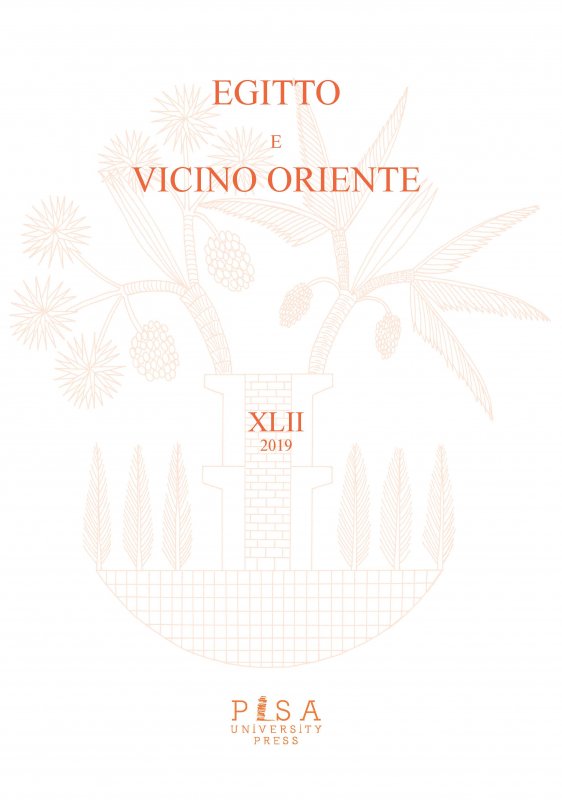
The autor publishes a faience statuette of the Egyptian god Bes who holds in its hands an oryx upside down. The parallels ‒ scarabs and cretulae ‒ come from Carthage. The provenance of the
statuette, from a private collection, is unknown; the proposed date is the 7-6th century B.C.
This paper aims to analyse the different steps in the phenomenon of material entanglement – often invisible in the archaeological record – between the Egyptian and Nubian material cultures of the Second Intermediate Period (1750-1500 BC) in the so-called ‘Egyptian Cemetery’ (southern part of the Eastern Cemetery) at Kerma. Faience figurines have been selected as the case study to analyse the processes of a. material appropriation, when an Egyptian artefact is integrated into a different cultural world; b. incorporation and tinkering, when the appropriated product is reshaped/modified at Kerma; c. hybridisation, when there is the generation of a product with a new ontological meaning, reinterpreted on a local background.
Publication of a fragmentary female statue found during the excavations of the mission of the University of Pisa at Dra Abu el-Naga and probably dated between the end of the 18th and the beginning of the 19th dynasty.
Publication of a stelophorous statue preserved in the Egyptian Museum of Florence (inv. no. 1793), which is inscribed for a troop commander, overseer of horses and overseer of recruits of the time of Amenhotep II. The statue has been probably found at Thebes, during Ippolito Rosellini’s excavations. The following article provides a brief history, description of the object and translations of its inscriptions. Statue typology and titles of its owner are also discussed.
In this contribution, the Egyptian text sources for the connection between bees and labour are investigated. In the course of research, four different examples were collected. Their time frame stretches from the Middle Kingdom to the Greco-Roman Period.
In this contribution, a new explanation for the word “xai” in the Egyptian pBrooklyn 35.1453 A, H/V, 8/11 is searched for. The previous interpretation as a fish-name turns out to be unconvincing. In this article, the word is analyzed as a secondary form of “xAw”, which is a common term for pots. The phonetic change between “A“ and “a“ assumes an extra importance. The solution can be backed up by excellent parallels.
The study of ancient Egyptian coffin decoration has received more interest in the last years. There has been an increase of archaeometric analysis to identify decoration techniques, ground layers, type of pigments, resins, varnishes, and binder media. Any degree of variation, indeed, can reflect stylistic choices, different costs of commission, availability of materials or the practices of a specific workshop. Despite the several recent investigation on Late Period, Ptolemaic and Roman coffins preserved in various museums, the most interesting works on the varnishes used on funerary objects during the New Kingdom (i.e. the yellow varnish and black varnish) have been published by Serpico and White. According to them, the first use of these two varnishes is dated back to the appearance of the black coffins with yellow decoration, which are the main topic of Lisa Sartini current PhD project. Therefore, we decided to analyse the organic compounds in the decoration of the black coffins of the Egyptian Museum in Florence, thanks to the collaboration between the Department of Civilisations and Forms of Knowledge and the Department of Chemistry and Industrial Chemistry of the University of Pisa. The sampled specimens are: the coffin of Kent (6526), the coffin of Nebtauy (6525), the lid and the mummy-board of Ipuy (2175 A-B) – all coming from Thebes and dated between the end of 18th dynasty-beginning 19th dynasty – and the coffin of Kenamun (9477) from Thebes, dated in the reign of Amenhotep II. Our research is in addition to the analysis already performed on the black coffins with yellow decoration exhibited in the British Museum, the Louvre Museum, the Museo Egizio of Turin and the Michael C. Carlos Museum.
This paper aims to present some hypothesis to interpret the occurrence and function of some vessels found set in the floor of the monastic housing units investigated during the last (2018) field season at the Byzantine site of Manqabad (Asyut, Egypt) by the archaeological mission of the University of Naples “L’Orientale” (UNIOR), the University of Rome “La Sapienza” Roma, the Project Sector of MSA, SCA local Inspectorate and the Restoration Sector. The material presented in this paper could be hopefully useful for comparison with similar Byzantine material in Egypt, since the actual function of those sunken pots is still unknown.
The glass finds were uncovered during the excavations carried out by the Istituto Papirologico “G. Vitelli” (University of Florence) in the area of Deir el Sombat, in the first spurs of the Gebel el ‘Adila to the Northeast of Antinoupolis (Middle Egypt). In October 2010 and 2011 the fragments from freeblown vessels were discovered in the cleaning of the court building serving as a camp for the police or a group of soldiers who had to supervise the activities in the quarries around Deir el Sombat. The fragments, coming from bottles, goblets and bowls are dated to 8th-9th centuries.
This paper explores the complex connections between the Platonic and Gnostic currents in Late Antiquity and attempts to explain how these ideas could have been transmitted to later ‘Gnostic’ groups in the Near East, such as the Mandaeans of southern Iraq, or to the various heterodox streams within Islam (ghulūw, Yezidis, etc.). As relevant case studies for this process of transmission, the study focuses on a few Late Antique elaborations of the latent dualism intrinsic to Plato’s philosophy: (a) the Hymn of the Pearl (composed in Syriac and only preserved in the apocryphal Acts of Thomas), (b) the Chaldean Oracles, written in Greek and preserved in quotations from Neoplatonic authors, and (c) the fragments of Numenius of Apamea. The careful comparison of these texts reveals striking affinities with regard to the philosophical and mythical motives employed, which could be characterised as a blend of Platonist and Gnostic ideas. A few of these motives are discussed in detail, e.g. the body as a material garment which has to be cast off, the dichotomy between memory and oblivion, the image of the soul serving as a slave in the material world. Relevant quotations regarding these motives are gathered in an appendix to the article. The occurrence of very similar ideas in Mandaean and Islamic Gnosticism further suggests a direct connection between these later groups and their Late Antique counterparts, either through oral channels, or via texts such as the ones discussed here.
Since 2016, the Italian Mission to Oman in collaboration with the Office of the Adviser to His Majesty the Sultan for Cultural Affairs started a new project on the Inqitat promontory in the Khor Rori area (Dhofar, Oman). These archaeological investigations have brought to light a huge settlement that provides important data on the first millennium BC in Dhofar. The materials studies and the radiocarbon dating suggest that the settlement was used until the Classical Period (1st-2nd cent. AD), contemporary at least in part with Sumhuram. This was an important South-Arabian city strongly connected with the frankincense trade. The site of Inqitat seems to suggest the presence of a long life architectural tradition, and open some interesting questions about the relation between South Arabian people, who were living in Sumhuram, and the local population of the area. Furthermore, this site could allow some understanding of the culture of the inhabitants of Dhofar.
In un articolo del 2017 Niu Ruji ha pubblicato uno specchio con croce e iscrizione in siriaco, conservato almeno dal 2013 al Museo Storico Nazionale di Pechino. La provenienza dello specchio è indicata genericamente come dalla Mongolia Interna. La località e le modalità del ritrovamento non sono note. Niu data lo specchio alla dinastia Yuan. Nell’articolo l’autore riesamina le informazioni fornite da Niu e fa notare alcune caratteristiche dell’iscrizione e della decorazione che suscitano dubbi sull’autenticità dello specchio.
牛汝极在2017年的一篇文章中发表了带有十字架和叙利亚文题字的镜子,至少自 2013年以来一直保存在北京国家博物馆。镜子的原产地说是从内蒙古来的。 位置和 发现方法未知。牛教授认为镜子是元朝时代的。在这篇文章中,作者回顾了牛汝极所 提供的信息,并指出了铭文和装饰的一些特征,这些特征引起对镜子真实性的怀疑。
